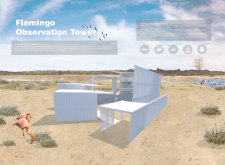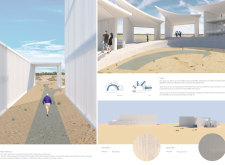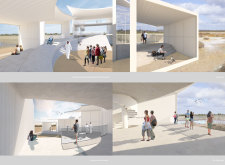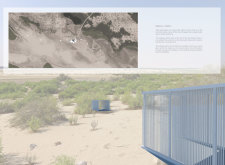5 key facts about this project
The Flamingo Observation Tower stands within the Al Wathba Wetland Reserve, a notable ecological habitat celebrated for its vibrant birdlife, especially the flamingos. This structure acts as a place for observing and learning about the natural surroundings. The design draws from the natural elegance of bird wings, creating a balance between functionality and an inviting connection to the wildlife and scenery.
Form and Function
The shape of the observation tower is inspired by the expansive form of a bird's wings. This design choice is not simply for visual appeal; it invites visitors to experience varying perspectives as they move around and through the structure. The tower serves as both a practical observation platform and a visual marker within the wetlands, enhancing visitors' appreciation of their natural surroundings while also providing protection from the sun.
Accessibility and Movement
Accessibility is a key element in the design. The structure features a ramp alongside stairs, facilitating ease of movement for all visitors, including those with disabilities. The gentle slope of the ramp ensures comfort, allowing users to explore different areas without difficulty. Stairs provide direct access to observation points, creating spaces for gathering and encouraging deeper interaction with the wetland environment.
Sensory Engagement
The entrance to the tower is designed to engage multiple senses. A tall wall made of responsive elements captures the surrounding sounds and movement of the wind. As visitors approach, the dynamic interaction between these elements and natural forces creates an immersive experience. The layout reinforces the connection between the tower and the birds, enhancing visitors' enjoyment of their visit by inviting them to listen and observe.
Material Considerations
Materials used in the construction include white wire and polycarbonate. These choices emphasize lightness and practicality. The polycarbonate panels allow natural light to enter while maintaining a sense of openness between the inside and outside. This selection of materials supports the structure's shape and helps the observation tower blend into the natural environment.
A box-shaped walkway pavilion leads from the observation tower to other parts of the reserve. It provides a shaded resting area for visitors. This pavilion is also an educational space, displaying information about the diverse wildlife in the wetlands. The design encourages visitors to reflect on the importance of the ecosystem while enjoying their surroundings.





















































